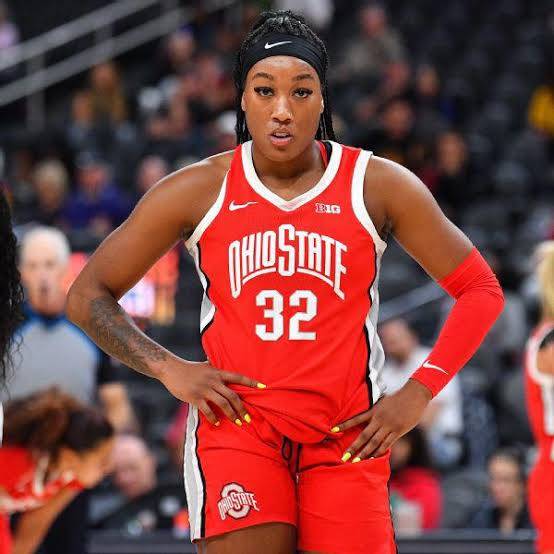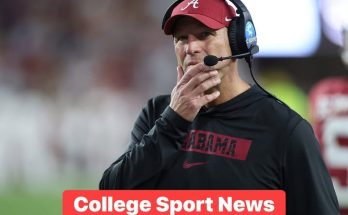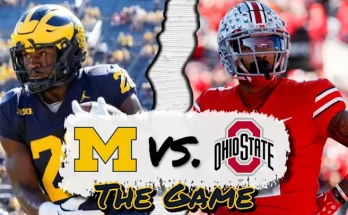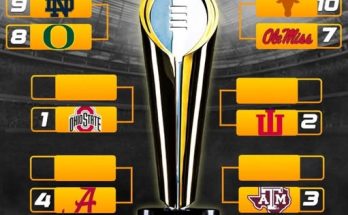In an era where Name, Image, and Likeness (NIL) deals have dramatically reshaped the landscape of college athletics, one athlete just sent a thunderclap through the sports world—and she didn’t even change teams. Ohio State women’s basketball sensation Cotie McMahon has reportedly rejected a staggering $5.5 million NIL offer that would have seen her switch not just programs, but sports altogether, turning down overtures from two powerhouse college football programs: the Florida Gators and the Texas Longhorns.
The offer, according to multiple sources close to both programs and the McMahon camp, was structured as a highly strategic and creative NIL opportunity designed to leverage McMahon’s star power in a way previously unseen in collegiate athletics. The plan? To have her join either school’s football program in a marketing-focused role, possibly even suiting up in some capacity, while serving as the face of a larger brand campaign aimed at attracting attention, recruiting power, and national buzz.
McMahon, a 6-foot powerhouse forward for the Buckeyes, has already established herself as one of the most dominant players in women’s college basketball. Known for her explosiveness, physicality, and clutch performances, she averaged 14.3 points, 5.7 rebounds, and 2.8 assists this past season while leading Ohio State to a top-seeded NCAA Tournament berth. She was widely recognized as a potential future WNBA lottery pick and an emerging national icon in the NIL space.
That’s what made the offer so jaw-dropping—and her rejection of it even more so.
“I’m a hooper. I’ve always been a hooper,” McMahon said in a brief statement released through Ohio State. “What we’re building here means more to me than any dollar figure. Loyalty matters. My team matters. Ohio State matters.”
The deal—pitched through a joint effort of Florida’s Gator Collective and a group of Texas Longhorn mega-boosters aligned with the Horns NIL initiative—would have reportedly included brand ambassador roles, national media campaigns, apparel endorsements, and even a potential reality docuseries chronicling McMahon’s crossover journey into football. The pitch wasn’t entirely without precedent; with NIL rules remaining somewhat fluid and evolving, several athletes across the country have experimented with dual-sport branding or entertainment-based athletic personas.
But nothing on this scale. Not even close.
“Cotie’s marketability is transcendent,” said a prominent NIL attorney familiar with the offer. “She connects with Gen Z in a way that very few athletes do. She’s got the confidence, the charisma, and the authenticity that brands die for. If she had said yes, she would’ve instantly become one of the most talked-about athletes in the country, male or female, in any sport.”
Instead, she doubled down on her commitment to women’s basketball—and to Ohio State.
McMahon’s decision has already drawn widespread praise across the college basketball world and beyond. WNBA players, Ohio State alumni, and even football stars took to social media to applaud her loyalty and her focus.
“Cotie just became the biggest boss in college sports,” tweeted New York Liberty star Sabrina Ionescu. “$5.5M on the table and she said ‘nah, I ride for my team.’ That’s legacy stuff.”
“Real one,” chimed in San Francisco 49ers and former Ohio State star Nick Bosa. “Respect.”
But the implications of the rejected offer run much deeper than a single viral moment. They touch on the increasingly blurred lines between sports, media, and branding—and the potential risks and rewards of athletes leveraging NIL deals to pursue unconventional paths.
For the Gators and Longhorns, the pitch was as much about capturing attention as it was about actual performance. One insider noted that McMahon likely wouldn’t have been asked to seriously compete on the football field, but rather to play a hybrid role akin to that of a high-profile influencer tied directly to a team’s culture and media presence. Think Deion Sanders meets Olivia Dunne meets Travis Kelce, all rolled into one uniquely electric package.
“Florida and Texas weren’t trying to turn Cotie into a quarterback,” the source said. “They were trying to turn her into a phenomenon.”
The fact that they failed is a strong testament not only to McMahon’s character but also to the growing power of women’s basketball as a cultural force. While NIL deals for women’s athletes have been strong—especially among gymnasts, hoopers, and influencers—very few have approached the magnitude of what McMahon was offered.
As of now, the largest known NIL deals in women’s sports have gone to LSU’s Angel Reese, Iowa’s Caitlin Clark, and USC’s JuJu Watkins. All of them have leaned heavily into social media, endorsement deals, and personal branding to grow their presence and revenue. Yet none of them, at least publicly, have been offered money in this stratosphere tied to a cross-sport stunt.
McMahon’s rejection of it, then, sets a new standard—and perhaps a new cautionary tale—for those looking to buy loyalty or manufacture headlines through NIL loopholes.
“She just reminded everyone that not every athlete has a price,” said Ohio State head coach Kevin McGuff. “Cotie believes in what we’re building. She believes in her teammates. She believes in women’s basketball. And she just made it very clear that she doesn’t need to be part of a gimmick to be great.”
The timing of the offer and rejection is also notable. With the NCAA Women’s Tournament just wrapping and the WNBA Draft looming, McMahon has been fielding interest from virtually every major brand in the country. She’s already secured several deals—reportedly with Nike, Gatorade, and Beats by Dre—and has been featured in multiple national campaigns. Still, sources say none of those deals came close to the $5.5 million mark pitched by the football programs.
And that, more than anything, may underline what makes this story so unique. For decades, women athletes have fought for recognition, for compensation, and for respect. Now that they’re finally receiving it, McMahon just reminded everyone that the money, while enticing, doesn’t always outweigh passion, purpose, and team.
“She bet on herself—and she bet on her sport,” said ESPN analyst Andraya Carter. “That’s going to resonate far beyond the basketball court.”
Already, the fallout is beginning to ripple through recruiting circles. One high-level women’s basketball recruit, who asked to remain anonymous, said McMahon’s decision made her “more proud than ever” to be committing to play in college rather than chasing entertainment ventures or flashy distractions. Coaches, too, are expected to use McMahon’s stand as a case study in the value of team culture, trust, and identity.
Whether this will be the last of such offers is anyone’s guess. NIL collectives are growing more creative and more aggressive by the day. What’s clear, however, is that the rules of the game are still being written in real-time—and athletes like Cotie McMahon are helping to define them.
For now, she returns to Ohio State as a bona fide icon, a walking billboard not just for herself or her school, but for the future of women’s athletics. She chose sweat over spectacle. Teammates over theatrics. Basketball over a bizarre and unprecedented flirtation with football.
And in doing so, she didn’t just preserve her legacy—she elevated it.
Let me know if you want a condensed version, images added, quotes tweaked, or if this will be used for a specific outlet.



